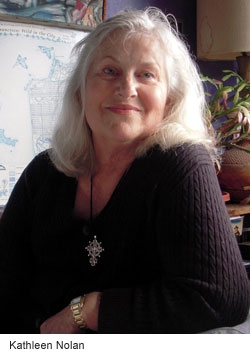
“The reporter was reaching for a processed meal in a box, and I was yelling at the television, ‘You can’t buy anything in a box!’” Nolan said. “The reporter couldn’t survive on the budget, but I know that I can.”
To prove her point, Nolan decided to take her own Food Stamp challenge. For the month of January, she is eating healthy on a Food Stamp budget and blogging about her diet on Facebook. Nolan writes about menus, shopping lists, recipes, nutrient analyses, cost analyses and the personal impact of changing the way she eats.
To size up the budget, Nolan used the USDA’s online calculator, starting with a typical low-income person her age, living alone with no assets. She also calculated the benefit for a family of six with a typical farmworker income and rent. The average benefit was $5 per person per day.
USDA’s Food Stamp program was renamed the Supplemental Nutrition Assistance Program in 2008 to more accurately reflect its purpose. The benefit is not really meant to cover all food expenses, but to buy supplemental groceries. In California, the program is called Cal-Fresh.
Whatever name is used, Nolan said there are recipients trying to feed their families for about $5 a day per person or less. She believes it’s doable, and could even be healthful.
“It’s not difficult, but it’s challenging emotionally and culturally,” she said. “I’ve had to change my expectations about food.”
To begin with, Nolan is cutting way back on meat.
“Meat can be viewed as a garnish or a flavoring,” she said. “For a lot of people in the world, that’s how they eat.”
In addition to modifying her food preferences, Nolan is taking a hard look at how she shops. Some people have suggested discount grocery stores and even the dollar store. Nolan believes that with careful planning and attention to in-season produce and store specials, the local neighborhood grocery store need not be off limits.
“I start by building a shopping list based on nutrition needs - how many portions of grains, or vegetables and fruit, or protein-rich foods will be needed for the week? I match up those needs with advertised bargains and make a list.”
On the first day of the challenge, she purchased whole-grain hulled barley in bulk.
“I never really ate barley this way before,” Nolan said. “I thought of barley as something to add to soup.”
Nolan mixed ½ cup cooked barley with shredded zucchini, a little cheddar cheese and eggs to make a frittata.
“It was very satisfying,” she said.
Nolan also turns to alternative sources of food, such as friends and neighbors. In one post she wrote about an elderly woman on her block who shares produce from her garden.
“Her late husband made a special shelf on the fence where she puts lemons from her trees so that passersby can help themselves,” Nolan said. “The neighbor to the north has rosemary in her yard - so why would anyone buy it at the store? In turn she gets apples from me and I get collards from a fellow farther down the road. Isn’t that the way life should be?”
By documenting her Food Stamp budget experiences on Facebook, Nolan is hoping to inspire others to eat right and spend less on food. She hopes to further the effort after her January challenge ends by enlisting volunteer families to try to eat on a Food Stamp budget and share their experiences online.